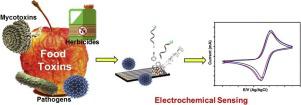Journal of Hazardous Materials ( IF 13.6 ) Pub Date : 2020-07-07 , DOI: 10.1016/j.jhazmat.2020.123379 Riya Gupta , Nadeem Raza , Sanjeev K. Bhardwaj , Kumar Vikrant , Ki-Hyun Kim , Neha Bhardwaj

|
There is a growing demand to protect food products against the hazard of microbes and their toxins. To satisfy such goals, it is important to develop highly sensitive, reliable, sophisticated, rapid, and cost-effective sensing techniques such as electrochemical sensors/biosensors. Although diverse forms of nanomaterials (NMs)-based electrochemical sensing methods have been introduced in markets, the reliability of commercial products is yet insufficient to meet the practical goal. In this review, we focused on: 1) sources of pathogenic microbes and their toxins; 2) possible routes of their entrainment in food, and 3) current development of NM-based biosensors to realize real-time detection of the target analytes. At last, future prospects and challenges in this research field are discussed.
中文翻译:

基于纳米材料的电化学生物传感器在食品基质中检测微生物毒素,致病菌的研究进展
人们越来越需要保护食品免受微生物及其毒素的危害。为了满足这些目标,重要的是开发高度灵敏,可靠,先进,快速且具有成本效益的传感技术,例如电化学传感器/生物传感器。尽管市场上已经引入了多种形式的基于纳米材料(NMs)的电化学传感方法,但是商用产品的可靠性仍不足以满足实际目标。在这篇综述中,我们着重于:1)病原微生物及其毒素的来源;2)诱使它们进入食物的可能途径,以及3)当前基于NM的生物传感器的开发,以实现目标分析物的实时检测。最后,讨论了该研究领域的未来前景和挑战。


























 京公网安备 11010802027423号
京公网安备 11010802027423号